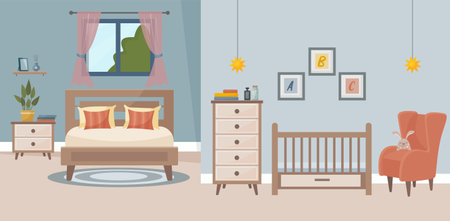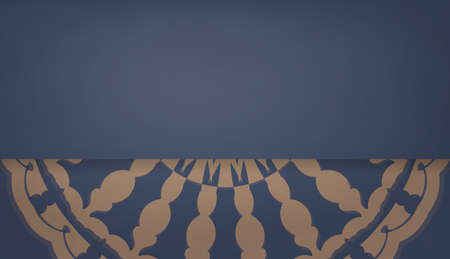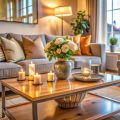Heritage Meets Modernity
The quintessential English country house is steeped in centuries of tradition, boasting ornate plasterwork, elegant wood panelling, and grand fireplaces. Yet, today’s leading interior designers are boldly reimagining these storied spaces, blending reverence for heritage with contemporary sensibilities. The result is a harmonious marriage of past and present—where original features are celebrated, yet innovative materials and modern comforts are seamlessly integrated. Contemporary design strategies often involve restoring period details while introducing subtle layers of texture and tone that reflect today’s aesthetic aspirations. Designers might pair time-worn flagstone floors with sculptural lighting or juxtapose antique furnishings against sleek, custom joinery. This thoughtful approach not only preserves the home’s narrative but also breathes new life into each room, making the country house a relevant and inviting retreat for modern living. Ultimately, this fusion of eras pays homage to Britain’s architectural legacy while ensuring that these cherished homes continue to inspire for generations to come.
2. Signature Styles: British Aesthetics Reimagined
Modern interpretations of the English country house require a sensitive balance between heritage and innovation. British interiors have always celebrated subtlety, comfort, and character—qualities that remain central but are now being reimagined by professional designers to suit contemporary lifestyles. This evolution is particularly evident in the way iconic design elements are adapted with a fresh sensibility.
Muted Palettes: A Contemporary Approach
The restrained colour palette is a hallmark of British country interiors, inspired by misty landscapes and ever-changing skies. Modern designers continue this tradition but introduce unexpected contrasts or accent hues for added dynamism. The result is an atmosphere both tranquil and visually engaging, where each room tells its own story without overwhelming the senses.
| Traditional Palette | Modern Interpretation |
|---|---|
| Sage green, duck egg blue, soft taupe | Misty greys with pops of ochre or teal |
| Creamy whites, faded rose | Crisp off-whites paired with charcoal or blush |
Period Panelling & Architectural Detailing
One cannot discuss English aesthetics without mentioning wood panelling—be it grand Georgian wainscoting or simple cottage boards. Professional designers now play with scale, finish, and placement, sometimes juxtaposing classic oak with sleek painted surfaces or inserting period mouldings in unexpected places. This blending of old and new brings warmth while avoiding pastiche.
Artful Layering: Textiles & Pattern Play
The British mastery of layering—whether through textiles, patterns, or curated objects—translates seamlessly to modern schemes. Designers today curate tactile experiences using both heritage fabrics (like linen and velvet) and innovative materials. Patterns may nod to William Morris but appear in oversized prints or on contemporary silhouettes, keeping spaces fresh yet rooted in tradition.
Key Elements of Reimagined British Style
| Element | Traditional Use | Modern Twist |
|---|---|---|
| Muted Colours | Wall paint & upholstery | Bolder accents & contrast trims |
| Wood Panelling | Entire walls in reception rooms | Feature sections or mixed finishes |
| Layered Textiles | Drapes & scatter cushions | Mixing vintage with artisan pieces |
| Patterned Wallpaper | Floral motifs throughout | Larger scale or geometric patterns |
This thoughtful reinvention ensures the English country house continues to feel relevant—honouring its past while inviting new stories into every space.

3. Spatial Flow and Light in Country Estates
One of the most compelling evolutions in English country house design is the shift from traditionally compartmentalised interiors to more open, fluid spatial arrangements. The stately homes of the past were often composed of a series of distinct rooms, each with its own purpose, connected by narrow corridors and grand staircases. While this layout reflected the social hierarchies and privacy norms of their era, it can feel restrictive to contemporary sensibilities that favour openness and connectivity.
Honouring Heritage While Embracing Openness
Professional designers today are faced with the challenge of creating inviting, light-filled spaces without erasing the architectural legacy that makes these homes unique. Rather than resorting to wholesale demolition, sensitive interventions—such as widening doorways, introducing internal glass partitions, or repositioning walls—can dramatically improve flow between areas. This approach allows for seamless transitions between living, dining, and entertaining spaces while preserving original cornices, panelling, or stonework that speak to the property’s history.
Maximising Natural Light
Another vital aspect is maximising natural light—a precious commodity in many rural estates. Designers often employ strategies like restoring or enlarging sash windows, incorporating skylights into attic conversions, or adding bespoke conservatories that echo Victorian garden rooms. These changes not only flood interiors with daylight but also establish stronger visual connections to the surrounding gardens and landscapes so integral to country living.
Blending Old and New with British Sensibility
The best case studies reveal a distinctly British approach: respecting patina and craftsmanship while subtly introducing contemporary elements. Steel-framed glass doors might separate a library from a drawing room without sacrificing sightlines; muted heritage colour palettes can be paired with modern furnishings to create spaces that feel both timeless and current. Ultimately, this balance between openness and tradition ensures that country estates remain both liveable and evocative of their storied pasts.
4. Sourcing and Sustainability
The reimagination of the English country house is increasingly defined by a thoughtful approach to sourcing and sustainability. Interior designers are championing British craftsmanship and supporting local artisans, resulting in spaces that not only honour heritage but also reflect a responsible, forward-thinking ethos. This synergy between tradition and eco-consciousness is at the heart of modern country house design.
The Importance of Local Craftsmanship
British-made furniture, handwoven textiles from Yorkshire, and ceramics from the Cotswolds are just a few examples of how local artisans contribute to an authentic sense of place. By working closely with these makers, designers ensure that each interior tells a uniquely British story—one rooted in regional skills passed down through generations. Commissioning bespoke pieces also allows for greater control over materials and methods, supporting both quality and environmental responsibility.
Sustainable Material Choices
Material selection plays a pivotal role in shaping eco-conscious interiors. Designers are increasingly opting for reclaimed timber, natural stone, wool, linen, and low-VOC finishes. These choices not only minimise environmental impact but also enhance the tactile richness and visual warmth typical of the English country house style.
Comparing Sustainable Materials Commonly Used in English Country House Interiors
| Material | Source | Sustainability Benefit | Design Impact |
|---|---|---|---|
| Reclaimed Timber | Historic buildings & salvage yards UK-wide | Reduces deforestation; repurposes existing resources | Adds character; showcases patina & history |
| British Wool | Local farms (e.g., Devon, Cumbria) | Biodegradable; renewable; supports rural economy | Provides warmth; traditional texture; timeless appeal |
| Limestone & Slate | Cotswolds, Wales, Lake District quarries | Durable; locally sourced reduces transport emissions | Classic flooring & fireplaces; natural variation enhances authenticity |
| Linen & Hemp Textiles | UK weavers & mills | Low water use; biodegradable; supports UK industry | Breezy drapery; soft furnishings with natural elegance |
Supporting Local Artisans: A Responsible Choice
Selecting locally made goods doesn’t just reduce carbon footprint—it also sustains craft traditions threatened by mass production. Whether it’s hand-thrown pottery or custom joinery, these collaborations foster community resilience and uphold the soul of the English countryside within each home.
Towards Eco-Conscious Luxury
The future of English country house interiors lies in balancing luxury with responsibility. Through mindful sourcing, designers create environments where beauty, heritage, and sustainability coexist—proving that thoughtful design can be both exquisite and environmentally sound.
5. Designing for Countryside Living
The English country house has long been a symbol of refined tradition and rural charm, yet contemporary living demands a thoughtful reimagining of these historic spaces. Today’s professional interior designers are redefining countryside homes, blending classic features with the practicalities and aesthetics that suit a modern rural lifestyle. Through insightful case studies, we see how quintessential elements—like boot rooms, bespoke kitchens, and restful drawing rooms—are being artfully transformed to meet both functional needs and aesthetic aspirations.
Reviving the Boot Room: Practical Elegance
Once a purely utilitarian entryway, the boot room now stands as a testament to British practicality fused with design flair. In one notable project in the Cotswolds, designers elevated the space with weathered oak benches, hand-forged hooks, and heritage tile flooring—ensuring muddy wellies can be stowed with ease while maintaining an air of rustic sophistication. The addition of integrated storage, tailored to accommodate everything from Barbour jackets to picnic hampers, demonstrates how traditional spaces can be adapted for contemporary countryside living.
Bespoke Kitchens: The Heart of Rural Homes
No English country house is complete without its kitchen—a social hub where tradition meets innovation. Case studies reveal a preference for handcrafted cabinetry in muted Farrow & Ball hues, deep Belfast sinks, and expansive worktops in honed stone or reclaimed wood. Designers often incorporate generous larders, Aga cookers, and hidden appliances to preserve period character while delivering modern convenience. These kitchens balance conviviality with craftsmanship, creating inviting spaces that celebrate seasonal produce and communal gatherings.
Restful Drawing Rooms: Inviting Calm and Connection
Drawing rooms in reimagined country houses serve as sanctuaries for relaxation and conversation. Designers are embracing layered lighting schemes—with antique wall sconces, statement lampshades in Liberty prints, and open fireplaces framed by original mantels—to cultivate warmth and intimacy. Upholstered sofas in tactile linens and velvet sit atop hand-knotted rugs, echoing the landscape outside through their earthy palettes. One standout project in Kent introduced French doors leading onto wildflower gardens, seamlessly connecting inside comforts with the beauty of the English countryside.
Case Study Highlights
Across these projects, there is a consistent respect for heritage alongside a willingness to innovate. Whether it’s repurposing stable blocks into airy home offices or converting attics into light-filled guest suites, designers are proving that the English country house can evolve gracefully for 21st-century living—without sacrificing its timeless appeal.
6. Case Studies: Expert Renovations
The true essence of reimagining the English country house comes alive in the hands of seasoned UK-based interior designers, whose work bridges tradition and contemporary flair. Below, we present a curated selection of case studies that exemplify how expert renovations can both honour heritage and embrace innovation.
Reviving a Georgian Manor in the Cotswolds
Interior designer Charlotte Pennington undertook the transformation of a centuries-old Georgian manor, delicately balancing the preservation of original cornices, fireplaces, and sash windows with the introduction of bespoke furnishings and modern art pieces. By layering muted Farrow & Ball tones with tactile linens and reclaimed oak flooring, Pennington created an inviting atmosphere that feels both timeless and current.
Blending Heritage with Modern Comforts
The design team at Ashford Interiors were tasked with updating a sprawling Victorian country house in Kent. Their approach involved meticulous restoration of stained glass and mosaic tiling while cleverly integrating underfloor heating, discreet lighting solutions, and open-plan living spaces. The result is a harmonious blend where grand staircases and ornate ceilings now coexist with sleek kitchen islands and contemporary British-made sofas.
A Rural Retreat Reborn in Yorkshire
Emma Sykes Studio brought new life to a derelict farmhouse on the edge of the Yorkshire Dales. By working closely with local craftspeople, they reinstated period details such as exposed stone walls and original beams. Meanwhile, bold botanical wallpapers, custom ironmongery, and locally sourced ceramics ensured a refreshed rural aesthetic—one that pays tribute to Yorkshire’s artisanal legacy while catering to the lifestyle needs of a modern family.
Celebrating the Past, Designing for the Future
These case studies collectively demonstrate how today’s leading UK interior designers are not only custodians of historical charm but also visionaries shaping future standards for country house living. Through thoughtful spatial planning, careful material selection, and an innate understanding of British design heritage, each project stands as a testament to the enduring allure—and adaptability—of the English country house.

